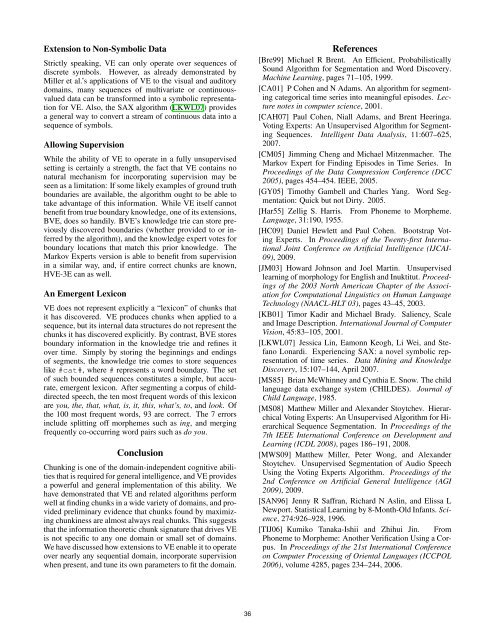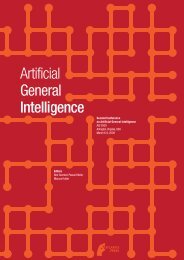Advances in Intelligent Systems Research - of Marcus Hutter
Advances in Intelligent Systems Research - of Marcus Hutter
Advances in Intelligent Systems Research - of Marcus Hutter
Create successful ePaper yourself
Turn your PDF publications into a flip-book with our unique Google optimized e-Paper software.
Extension to Non-Symbolic Data<br />
Strictly speak<strong>in</strong>g, VE can only operate over sequences <strong>of</strong><br />
discrete symbols. However, as already demonstrated by<br />
Miller et al.’s applications <strong>of</strong> VE to the visual and auditory<br />
doma<strong>in</strong>s, many sequences <strong>of</strong> multivariate or cont<strong>in</strong>uousvalued<br />
data can be transformed <strong>in</strong>to a symbolic representation<br />
for VE. Also, the SAX algorithm (LKWL07) provides<br />
a general way to convert a stream <strong>of</strong> cont<strong>in</strong>uous data <strong>in</strong>to a<br />
sequence <strong>of</strong> symbols.<br />
Allow<strong>in</strong>g Supervision<br />
While the ability <strong>of</strong> VE to operate <strong>in</strong> a fully unsupervised<br />
sett<strong>in</strong>g is certa<strong>in</strong>ly a strength, the fact that VE conta<strong>in</strong>s no<br />
natural mechanism for <strong>in</strong>corporat<strong>in</strong>g supervision may be<br />
seen as a limitation: If some likely examples <strong>of</strong> ground truth<br />
boundaries are available, the algorithm ought to be able to<br />
take advantage <strong>of</strong> this <strong>in</strong>formation. While VE itself cannot<br />
benefit from true boundary knowledge, one <strong>of</strong> its extensions,<br />
BVE, does so handily. BVE’s knowledge trie can store previously<br />
discovered boundaries (whether provided to or <strong>in</strong>ferred<br />
by the algorithm), and the knowledge expert votes for<br />
boundary locations that match this prior knowledge. The<br />
Markov Experts version is able to benefit from supervision<br />
<strong>in</strong> a similar way, and, if entire correct chunks are known,<br />
HVE-3E can as well.<br />
An Emergent Lexicon<br />
VE does not represent explicitly a “lexicon” <strong>of</strong> chunks that<br />
it has discovered. VE produces chunks when applied to a<br />
sequence, but its <strong>in</strong>ternal data structures do not represent the<br />
chunks it has discovered explicitly. By contrast, BVE stores<br />
boundary <strong>in</strong>formation <strong>in</strong> the knowledge trie and ref<strong>in</strong>es it<br />
over time. Simply by stor<strong>in</strong>g the beg<strong>in</strong>n<strong>in</strong>gs and end<strong>in</strong>gs<br />
<strong>of</strong> segments, the knowledge trie comes to store sequences<br />
like #cat#, where # represents a word boundary. The set<br />
<strong>of</strong> such bounded sequences constitutes a simple, but accurate,<br />
emergent lexicon. After segment<strong>in</strong>g a corpus <strong>of</strong> childdirected<br />
speech, the ten most frequent words <strong>of</strong> this lexicon<br />
are you, the, that, what, is, it, this, what’s, to, and look. Of<br />
the 100 most frequent words, 93 are correct. The 7 errors<br />
<strong>in</strong>clude splitt<strong>in</strong>g <strong>of</strong>f morphemes such as <strong>in</strong>g, and merg<strong>in</strong>g<br />
frequently co-occurr<strong>in</strong>g word pairs such as do you.<br />
Conclusion<br />
Chunk<strong>in</strong>g is one <strong>of</strong> the doma<strong>in</strong>-<strong>in</strong>dependent cognitive abilities<br />
that is required for general <strong>in</strong>telligence, and VE provides<br />
a powerful and general implementation <strong>of</strong> this ability. We<br />
have demonstrated that VE and related algorithms perform<br />
well at f<strong>in</strong>d<strong>in</strong>g chunks <strong>in</strong> a wide variety <strong>of</strong> doma<strong>in</strong>s, and provided<br />
prelim<strong>in</strong>ary evidence that chunks found by maximiz<strong>in</strong>g<br />
chunk<strong>in</strong>ess are almost always real chunks. This suggests<br />
that the <strong>in</strong>formation theoretic chunk signature that drives VE<br />
is not specific to any one doma<strong>in</strong> or small set <strong>of</strong> doma<strong>in</strong>s.<br />
We have discussed how extensions to VE enable it to operate<br />
over nearly any sequential doma<strong>in</strong>, <strong>in</strong>corporate supervision<br />
when present, and tune its own parameters to fit the doma<strong>in</strong>.<br />
References<br />
[Bre99] Michael R Brent. An Efficient, Probabilistically<br />
Sound Algorithm for Segmentation and Word Discovery.<br />
Mach<strong>in</strong>e Learn<strong>in</strong>g, pages 71–105, 1999.<br />
[CA01] P Cohen and N Adams. An algorithm for segment<strong>in</strong>g<br />
categorical time series <strong>in</strong>to mean<strong>in</strong>gful episodes. Lecture<br />
notes <strong>in</strong> computer science, 2001.<br />
[CAH07] Paul Cohen, Niall Adams, and Brent Heer<strong>in</strong>ga.<br />
Vot<strong>in</strong>g Experts: An Unsupervised Algorithm for Segment<strong>in</strong>g<br />
Sequences. <strong>Intelligent</strong> Data Analysis, 11:607–625,<br />
2007.<br />
[CM05] Jimm<strong>in</strong>g Cheng and Michael Mitzenmacher. The<br />
Markov Expert for F<strong>in</strong>d<strong>in</strong>g Episodes <strong>in</strong> Time Series. In<br />
Proceed<strong>in</strong>gs <strong>of</strong> the Data Compression Conference (DCC<br />
2005), pages 454–454. IEEE, 2005.<br />
[GY05] Timothy Gambell and Charles Yang. Word Segmentation:<br />
Quick but not Dirty. 2005.<br />
[Har55] Zellig S. Harris. From Phoneme to Morpheme.<br />
Language, 31:190, 1955.<br />
[HC09] Daniel Hewlett and Paul Cohen. Bootstrap Vot<strong>in</strong>g<br />
Experts. In Proceed<strong>in</strong>gs <strong>of</strong> the Twenty-first International<br />
Jo<strong>in</strong>t Conference on Artificial Intelligence (IJCAI-<br />
09), 2009.<br />
[JM03] Howard Johnson and Joel Mart<strong>in</strong>. Unsupervised<br />
learn<strong>in</strong>g <strong>of</strong> morphology for English and Inuktitut. Proceed<strong>in</strong>gs<br />
<strong>of</strong> the 2003 North American Chapter <strong>of</strong> the Association<br />
for Computational L<strong>in</strong>guistics on Human Language<br />
Technology (NAACL-HLT 03), pages 43–45, 2003.<br />
[KB01] Timor Kadir and Michael Brady. Saliency, Scale<br />
and Image Description. International Journal <strong>of</strong> Computer<br />
Vision, 45:83–105, 2001.<br />
[LKWL07] Jessica L<strong>in</strong>, Eamonn Keogh, Li Wei, and Stefano<br />
Lonardi. Experienc<strong>in</strong>g SAX: a novel symbolic representation<br />
<strong>of</strong> time series. Data M<strong>in</strong><strong>in</strong>g and Knowledge<br />
Discovery, 15:107–144, April 2007.<br />
[MS85] Brian McWh<strong>in</strong>ney and Cynthia E. Snow. The child<br />
language data exchange system (CHILDES). Journal <strong>of</strong><br />
Child Language, 1985.<br />
[MS08] Matthew Miller and Alexander Stoytchev. Hierarchical<br />
Vot<strong>in</strong>g Experts: An Unsupervised Algorithm for Hierarchical<br />
Sequence Segmentation. In Proceed<strong>in</strong>gs <strong>of</strong> the<br />
7th IEEE International Conference on Development and<br />
Learn<strong>in</strong>g (ICDL 2008), pages 186–191, 2008.<br />
[MWS09] Matthew Miller, Peter Wong, and Alexander<br />
Stoytchev. Unsupervised Segmentation <strong>of</strong> Audio Speech<br />
Us<strong>in</strong>g the Vot<strong>in</strong>g Experts Algorithm. Proceed<strong>in</strong>gs <strong>of</strong> the<br />
2nd Conference on Artificial General Intelligence (AGI<br />
2009), 2009.<br />
[SAN96] Jenny R Saffran, Richard N Asl<strong>in</strong>, and Elissa L<br />
Newport. Statistical Learn<strong>in</strong>g by 8-Month-Old Infants. Science,<br />
274:926–928, 1996.<br />
[TIJ06] Kumiko Tanaka-Ishii and Zhihui J<strong>in</strong>. From<br />
Phoneme to Morpheme: Another Verification Us<strong>in</strong>g a Corpus.<br />
In Proceed<strong>in</strong>gs <strong>of</strong> the 21st International Conference<br />
on Computer Process<strong>in</strong>g <strong>of</strong> Oriental Languages (ICCPOL<br />
2006), volume 4285, pages 234–244, 2006.<br />
36













